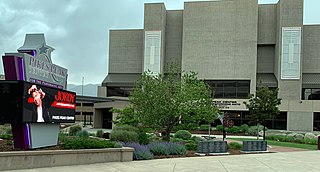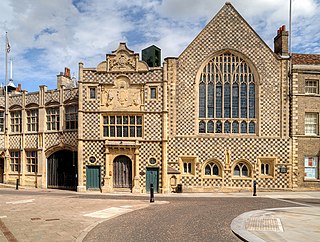
Norfolk is a ceremonial county in the East of England and East Anglia. It borders Lincolnshire and The Wash to the north-west, the North Sea to the north and east, Cambridgeshire to the west, and Suffolk to the south. The largest settlement is the city of Norwich.

The Empire, Leicester Square is a cinema currently operated by Cineworld on the north side of Leicester Square, London, United Kingdom.

An auditorium is a room built to enable an audience to hear and watch performances. For movie theatres, the number of auditoria is expressed as the number of screens. Auditoria can be found in entertainment venues, community halls, and theaters, and may be used for rehearsal, presentation, performing arts productions, or as a learning space.

A theater, theatre or playhouse, is a structure where theatrical works, performing arts and musical concerts are presented. The theater building serves to define the performance and audience spaces. The facility usually is organized to provide support areas for performers, the technical crew and the audience members, as well as the stage where the performance takes place.
Walter Nugent Monck CBE (1878–1958) was an English theatre director and founder of Maddermarket Theatre, Norwich.
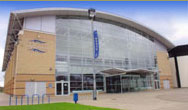
Grimsby Auditorium is a theatre situated on Cromwell Road, in Grimsby, North East Lincolnshire. With a seated audience capacity of 1,200 the Grimsby Auditorium is the largest professional theatre in Lincolnshire, and one of the larger theatres in the East of England. Built in 1995, it is today managed by Lincs Inspire on behalf of its owners North East Lincolnshire Council.

William Bridges-Adams was an English theatre director and designer, associated closely with the Shakespeare Memorial Theatre, Stratford-upon-Avon, from 1919 until 1934.

Bridlington Spa is a dance hall, theatre and conference centre in Bridlington, East Riding of Yorkshire, England. Refurbished between 2006 and 2008 and further updated with a new branding in 2016, the venue boasts a large Art Deco ball room, Edwardian theatre, art gallery and a selection of other meeting and event spaces; all featuring outstanding views over Bridlington's South Bay.
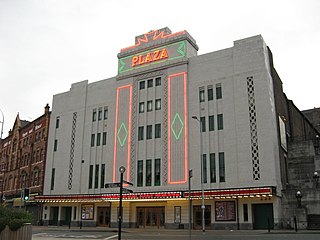
The Plaza is a Grade II* listed art deco single-screen cinema and theatre in Mersey Square, Stockport, England. It opened in 1932, its construction having involved the excavation of the sandstone cliff behind it. After an initial closure in 1966 and a subsequent period in use as a bingo hall by Rank Leiure, it has now been restored as a cinema and theatre, showing films and staging live shows.
The Elizabethan Stage Society was a theatrical society dedicated to putting on productions of drama from the Elizabethan and Jacobean eras, particularly those of William Shakespeare. It was founded in 1895 by William Poel. Its minimal scenery, platform stage, quick scene changes and emphasis on the poetry was in direct and deliberate contrast to Herbert Beerbohm Tree and Henry Irving's large-set productions, and were a major influence on later staging and production of these works. Walter Nugent Monck was its stage manager in the 1920s, and its actors included Ben Greet

The Marina is a theatre and cinema in Lowestoft, Suffolk, originally opened in the Victorian era. The venue has an auditorium seating 800. It plays host to major West End productions, top comedy, orchestral concerts, touring drama and musical productions, opera, ballet, music, dance and celebrity concerts as well as operating a successful cinema operation - boasting the largest screen and cinema auditoria in the town. The Marina annually hosts the largest professional pantomime on the East Anglian Coast.

The Lessing Theater was a theatre in the Mitte district of Berlin, Germany. It opened in 1888 and was destroyed in April 1945 in a bombing raid; its ruins were demolished after World War II.
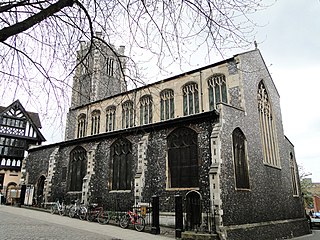
The Church of St John the Baptist, Maddermarket, is a redundant Anglican church in the city of Norwich, Norfolk, England. It is recorded in the National Heritage List for England as a designated Grade I listed building, and is in the care of the Churches Conservation Trust.

Strangers' Hall is a museum of domestic history located in Norwich, Norfolk, UK. It is a Grade I listed building. It is named after the Flemish Protestants who fled from persecution in Flanders and who were housed in the building.

Paragon Theatre is a heritage-listed cinema and theatre at 75 Churchill Street, Childers, Bundaberg Region, Queensland, Australia. It was designed by Arthur Robson and built in 1927 by P Mellefont, Jnr. It was added to the Queensland Heritage Register on 28 April 2000.

The Scone Civic Theatre is a heritage-listed cinema at 144 Kelly Street, Scone, Upper Hunter Shire, New South Wales, Australia. It was designed by Guy Crick and Bruce Furse and built from 1937 to 1938 by Mr A. F. Little. The property is privately owned. It was added to the New South Wales State Heritage Register on 21 February 2003.

The Allen Elizabethan Theatre has evolved since the founding of the Oregon Shakespeare Festival when the first performance of Twelfth Night was presented on July 2, 1935.

The Holborn Theatre was a theatre on High Holborn in London which opened in 1867 as the New Royal Amphitheatre and operated as an equestrian ring and theatre until 1886. During its short existence the theatre underwent numerous name changes, becoming the Holborn Theatre in 1884.







